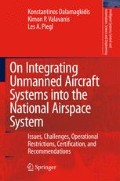The primary goal of UAS regulations is the assurance of safe operations. This goal is quantified by most national aviation agencies as an “Equivalent Level of Safety”, or ELOS, with that of manned aviation.
Since many UAS are based on military or general aviation aircraft, the increased risk stems from the separation of the pilot from the cockpit and the level of automation introduced, rather than the design and construction of the airframe of the UA itself. On the other hand it need be noted that manned aviation has also benefited from increased automation. A considerable percentage of modern commercial aviation operations – including landing – takes place autonomously with the pilots responsible only for monitoring the computers [10].
This Chapter specifies what the ELOS requirement entails for UAS regulations. To accomplish this, the safety performance of manned aviation need first be evaluated. Next a novel model is presented to derive reliability requirements for achieving TLS for ground impact and mid-air collision accidents.
The provided definitions for the terms hazard and accident given in Chap. 1; the first as the necessary conditions that may lead to the second and the latter as an unwanted outcome with associated damages. As a result, the expected rate of occurrence of an accident can be calculated from the expected rate of hazards. Equivalently, given an accident rate limit, a UAS can be designed so that its components have sufficient reliability to ensure that set limit is not violated.
Access this chapter
Tax calculation will be finalised at checkout
Purchases are for personal use only
Preview
Unable to display preview. Download preview PDF.
References
Center for International Earth Science Information Network (CIESIN), Columbia University, Centro Internacional de Agricultura Tropical (CIAT) (2005) Gridded Population of the World Version 3 (GPWv3): Population Density Grids. Palisades, NY: Socioeconomic Data and Applications Center (SEDAC), Columbia University, URL http://sedac.ciesin.columbia.edu/gpw
Clothier R, Walker R (2006) Determination and evaluation of UAV safety objectives. In: 21st International Unmanned Air Vehicle Systems Conference, pp 18.1–18.16
Clothier R, Walker R, Fulton N, Campbell D (2007) A casualty risk analysis for unmanned aerial system (UAS) operations over inhabited areas. In: 12th Australian International Aerospace Congress, 2nd Australasian Unmanned Air Vehicles Conference
Dalamagkidis K, Valavanis KP, Piegl LA (2008) On safety and reliability requirements for integration of civil unmanned aircraft in the national airspace system, submitted for review
Department of Defense (2007) Unmanned systems safety guide for DoD acquisition. First Edition (Version.96)
European Aviation Safety Agency (EASA) (2005) A-NPA, No. 16/2005, policy for unmanned aerial vehicle (UAV) certification
European Aviation Safety Agency (EASA) (2007) Certification specification 25 (CS25). Amendment 3
Federal Aviation Administration (1999) Equipment, systems and installations in part 23 airplanes. AC 23.1309-1C
FSF editorial staff (2005) See whatś sharing your airspace. Flight Safety Digest 24(5):1–26
Haddon DR,Whittaker CJ (2002) Aircraft airworthiness certification standards for civil UAVs. UK Civil Aviation Authority
Hayhurst KJ, Maddalon JM, Miner PS, Szatkowski GN, Ulrey ML, Dewalt MP, Spitzer CR (2007) Preliminary considerations for classifying hazards of unmanned aircraft systems. Tech. Rep. NASA TM-2007-214539, National Aeronautics and Space Administration, Langley Research Center, Hampton, Virginia
Joint Capability Group on Unmanned Aerial Vehicles (2007) STANAG 4671 — Unmanned Aerial Vehicle Systems Airworthiness Requirements (USAR). draft, NATO Naval Armaments Group
Joint JAA/Eurocontrol Initiative on UAVs (2004) A concept for European regulations for civil unmanned aerial vehicles (UAV). Final Report
National Transportation Safety Board (NTSB) (2008) Accident database and synopses. URL http://www.ntsb.gov/ntsb/query.asp
National Transportation Safety Board (NTSB) (2008) Aviation accident statistics. URL http://www.ntsb.gov/aviation/Stats.htm
Office of the Secretary of Defence, DoD, US (2005) Unmanned aircraft systems roadmap 2005–2030. Report
Range Safety Group, Range Commanders Council (1999) Range safety criteria for unmanned air vehicles — rationale and methodology supplement. Supplement to document 323–99
Range Safety Group, Range Commanders Council (2007) Common risk criteria standards for national test ranges: Supplement. Supplement to document 321-07
Weibel RE, Hansman RJ (2003) Safety considerations for operation of small unmanned aerial vehicles in civil airspace. Presented in MIT Joint University Program Quarterly Meeting
Weibel RE, Hansman RJ (2004) Safety considerations for operation of different classes of UAVS in the nas. In: AIAA 4th Aviation Tehcnology, Integration and Operations Forum, AIAA 3rd Unmanned Unlimited Technical Conference, Workshop and Exhibit
Editor information
Editors and Affiliations
Rights and permissions
Copyright information
© 2009 Springer Science+Business Media, B.V
About this chapter
Cite this chapter
(2009). UAS Safety Assessment and Functional Requirements. In: Dalamagkidis, K., Valavanis, K.P., Piegl, L.A. (eds) On Integrating Unmanned Aircraft Systems into the National Airspace System. Intelligent Systems, Control and Automation: Science and Engineering, vol 36. Springer, Dordrecht. https://doi.org/10.1007/978-1-4020-8672-4_5
Download citation
DOI: https://doi.org/10.1007/978-1-4020-8672-4_5
Publisher Name: Springer, Dordrecht
Print ISBN: 978-1-4020-8671-7
Online ISBN: 978-1-4020-8672-4
eBook Packages: EngineeringEngineering (R0)

